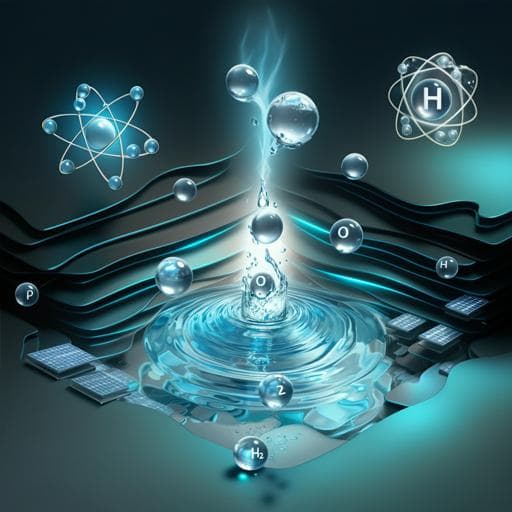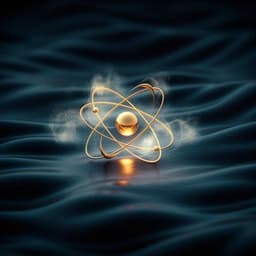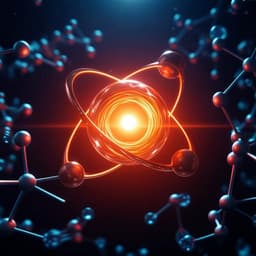
Engineering and Technology
Atomic-Scale Architectured Ir Single-Atom Catalysts for Enhanced Photoelectrochemical Water Oxidation
S. E. Jun, Y. H. Kim, et al.
Discover the groundbreaking development of a high-performance photoanode device utilizing atomically dispersed iridium single atoms for efficient photoelectrochemical water oxidation, as reported by the talented researchers including Seung Eun Jun and Young Hun Kim from the Korea Research Institute of Standards and Science.
~3 min • Beginner • English
Introduction
Single-atom catalysts (SACs) offer unique geometric and electronic structures that can enhance catalytic activity and stability compared with conventional nanoparticle catalysts. However, for photoelectrochemical (PEC) applications, challenges include creating stable anchoring sites for single atoms on photoelectrodes and elucidating their coordination and electronic environments. Critically, unlike purely electrocatalytic systems, PEC performance is strongly governed by photogenerated charge-carrier recombination at the surface and charge transport to the electrolyte; yet, the kinetics of carriers on SAC-decorated photoelectrodes have not been directly probed. Addressing these gaps could enable low-cost, high-efficiency, durable atomically dispersed catalysts for PEC devices.
Literature Review
The study builds on prior advances in MIS photoanodes that mitigate Fermi level pinning via ultrathin insulators, and on the rising field of SACs where strong metal–support interactions modulate single-atom valence and coordination to improve activity and stability. NiO/Ni has been used as a robust, alkaline-stable OER cocatalyst/passivation layer with intrinsic Ni vacancies suitable for anchoring single atoms. Prior Ir-based catalysts for PEC OER typically rely on higher Ir loadings (films, nanoparticles) and lack direct analysis of photocarrier kinetics on SAC-modified photoelectrodes.
Methodology
Device fabrication: Phosphorus-doped (100) n-type Si wafers (1–10 Ω cm, 1.5 × 1.5 cm2) were cleaned (acetone, isopropanol, DI water, ultrasonication, 15 min each) and HF-dipped (10 s) to remove native oxide. A 1 nm ZrO2 tunneling insulator and a 2 nm Ni layer were sequentially deposited by e-beam evaporation (0.1 Å s−1, 1.0 × 10−4 mTorr). During ALD at 250 °C, the Ni surface was thermally oxidized to NiO forming NiO/Ni. Ir ALD used tricarbonyl (η-1,2,3)-1,2,3-tri(tert-butyl)-cyclopropenyl iridium (C18H27IrO3, TICP) and O2 (99.99%) in a traveling-wave ALD reactor (precursor at 55 °C, N2 carrier/purge 100 sccm). A standard cycle: precursor pulse 7 s, purge 10 s, reactant pulse 5 s, purge 10 s. Single Ir ALD cycle produced Ir SAs; 25, 100, and 200 cycles yielded Ir nanoclusters (NCs), Ir film, and thicker film (Ir film-T). A control NiO/Ni/ZrO2/n-Si was fabricated by the same thermal process without the Ir precursor.
Characterization: Cross-sectional TEM (FIB-prepared; JEM-2100F) and HAADF-STEM with EDX mapping (Themis Z 60–300, 300 kV) confirmed lattice structure and isolated Ir atoms substituting Ni sites. XRD (Cu Kα) identified Ir film crystallinity; SAs/NCs showed no Ir crystallinity. Optical transmittance (300–1200 nm) probed light management. XPS (AXIS SUPRA) analyzed Ir 4f, O 1s (Shirley background, XPSpeak41 fitting). XAFS at Ir L3-edge (PLS 8C, fluorescence mode) with Demeter (Athena/Artemis) provided XANES and FT-EXAFS; WT-EXAFS distinguished Ir–O vs Ir–Ir scattering. ICP-MS (NexION 350D) quantified Ir loading for mass activity. UV–Vis (V-770) measured transmittance.
Photoelectrochemistry: Xe lamp (AM 1.5G, 100 mW cm−2). Three-electrode PEC in 1 M NaOH (ref: Ag/AgCl; counter: Pt). Acidic tests in 0.5 M H2SO4 (ref: SCE; counter: graphite). LSV scan 10 mV s−1; potentials converted to RHE. Mott–Schottky determined flat-band potentials. EIS: 250 kHz–1 Hz, 10 mV amplitude, fitted with equivalent circuit to extract Rct components. IPCE with monochromator at 1.23 V vs RHE. Chronoamperometry (1.23 V vs RHE) for stability and GC (Agilent 7890B) for O2 quantification and Faradaic efficiency.
IMPS: Electrochemical workstation/potentiostat (Zennium, PP211), frequency 100 kHz–0.1 Hz, white light 300 W m−2; ktrans + krec = 2πfmax; charge transfer efficiency ηtrans = ktrans/(ktrans + krec) from low-/high-frequency intercepts.
Computations: Spin-polarized DFT (VASP, PAW, PBE-GGA, 450 eV cutoff, DFT+U on Ni d with U = 6.45 eV). Surfaces: NiO (100)/(001) with Ir substituted at Ni vacancy site, and IrO2 (110); p(3×3) slabs with ≥15 Å vacuum; constrained bottom layers; force/energy convergence 0.05 eV Å−1/1×10−5 eV. OER via CHE model, four-step mechanism, free energy corrections (EZPE, entropy at 298 K). Theoretical overpotential η = max(ΔGi)/e − 1.23 V. CI-NEB for kinetic barriers of PDS, exploring incident OH angles.
Key Findings
- Structure and chemistry: HAADF-STEM directly visualized isolated Ir atoms on NiO, occupying Ni sites with periodicity; EDX mapping showed homogeneous dispersion. XPS: Ir SAs only exhibited Ir 4f doublet near 64.6/61.6 eV (Ir3+/Ir4+), unlike NCs/films that included metallic Ir (Ir0). XANES: Ir SAs white line closer to IrO2, indicating high oxidation state. FT-EXAFS and WT-EXAFS: Ir SAs showed only Ir–O scattering (~1.54 Å in R-space), with no Ir–Ir contribution, confirming atomic dispersion.
- MIS and photovoltage: Inserting 1 nm ZrO2 reduced Fermi level pinning, shifting onset cathodically and increasing saturation photocurrent. Mott–Schottky: flat-band potential shifted from −0.4 V (Ni/n-Si) to −0.7 V vs Ag/AgCl (Ni/ZrO2/n-Si), evidencing increased photovoltage. Direct comparison on p-Si yielded a photovoltage of ~550 mV.
- PEC performance (1 M NaOH, AM 1.5G): Ir SAs/NiO/Ni/ZrO2/n-Si achieved onset potential 0.97 V vs RHE, saturation current density ~38 mA cm−2, and photocurrent density 27.7 mA cm−2 at 1.23 V vs RHE. Ir SAs outperformed NCs, films, and thick films across the potential range; overly thick Ir films suppressed photogeneration and favored only EC OER.
- IPCE (1.23 V vs RHE): ~75% (Ir SAs), increased from ~40% (Ir film) and higher than NCs. Controls: ~40% (NiO/Ni/ZrO2/n-Si), ~65% (Ir SAs/NiO/Ni/n-Si), and ~0% when Ir was deposited without NiO anchoring layer.
- Mass activity (photoelectrochemical): Normalizing photocurrent by Ir mass (ICP-MS), Ir SAs exceeded NCs by 115× (1.23 V) and 98.5× (1.6 V), and films by 679× and 344.6×, respectively.
- Faradaic efficiency and stability: ~100% O2 Faradaic yield during chronoamperometry. Long-term stability: maintained performance over 130 h at 1.23 V vs RHE, attributed to robust NiO/Ni and strong Ir–NiO interactions. Prior to degradation, Ir chemical state remained unchanged.
- IMPS/EIS carrier kinetics: IMPS showed highest ηtrans for Ir SAs, indicating suppressed surface recombination and enhanced charge transfer. EIS (Nyquist): two semicircles assigned to transport to surface (Rct,1) and catalyst/electrolyte interface (Rct,2). Ir SAs showed lowest Rct,2 among samples; Ir film exhibited twice higher Rct,1 due to added NiO/Ir film resistance. ηtrans and Rct,surface–electrolyte were inversely correlated across morphologies.
- DFT mechanistic insights: On NiO (100), PDS was OH* → O* with η ≈ 1.09 V; on IrO2 (110), PDS O* → OOH* with η ≈ 0.633 V; on Ir SAs/NiO (100), PDS O* → OOH* with a lower η ≈ 0.621 V, outperforming IrO2. CI-NEB found a small kinetic barrier ~0.05 eV for the PDS at favorable OH incidence. Charge density difference/Bader analysis revealed strong localized polarization between isolated Ir and OH intermediates, promoting hole transfer to adsorbates.
Discussion
The synergy of an MIS junction (ZrO2) and atomically dispersed Ir on NiO/Ni addresses two main bottlenecks in Si photoanodes: interfacial Fermi level pinning and surface recombination. ZrO2 suppresses interface states, enlarging photovoltage and enabling efficient hole extraction. NiO/Ni provides robust OER catalysis and abundant Ni vacancies that both stabilize and electronically modulate Ir into an oxidized state favorable for OER. By isolating Ir atoms, recombination centers associated with metallic films/clusters are minimized, while the density of catalytically active sites is maximized per Ir mass. Frequency-domain analyses quantitatively confirm that Ir SAs achieve the highest charge transfer efficiency and lowest interfacial resistance, correlating directly with enhanced photocurrent and reduced onset potential. DFT rationalizes these observations, showing that isolated Ir centers on NiO lower the OER thermodynamic barrier at the critical O* → OOH* step and create a strong local electric field that facilitates hole transfer to adsorbates, thus accelerating surface kinetics. Collectively, the approach yields record PEC OER performance with near-unity Faradaic efficiency and long-term stability despite ultra-low Ir loading.
Conclusion
This work demonstrates a high-performance Si photoanode architecture that integrates a ZrO2 MIS junction with NiO/Ni thin-film cocatalyst hosting atomically dispersed Ir via single-cycle ALD. Structural and spectroscopic evidence confirm isolated, oxidized Ir atoms anchored in Ni vacancies. IMPS/EIS reveal that Ir SAs suppress surface recombination and enhance charge transfer, while DFT shows reduced OER overpotential and favorable PDS kinetics at isolated Ir sites. The device achieves 27.7 mA cm−2 at 1.23 V vs RHE with 130 h stability and ~100% Faradaic efficiency, with exceptionally high photoelectrochemical mass activity versus Ir NCs and films. Future work may explore: (i) extending SAC anchoring strategies to other supports and photoabsorbers, (ii) operando spectroscopy to track single-atom stability under illumination, (iii) optimizing insulator thickness/composition to balance photovoltage and transport, and (iv) acid-stable SAC architectures for broader pH operation.
Limitations
- Acidic stability: NiO/Ni-based thin films are vulnerable in acidic media; Ir SAs and NCs on NiO/Ni lost catalytic function in 0.5 M H2SO4, while continuous Ir films protected NiO/Ni and remained active.
- Thickness trade-offs: Excessive Ir deposition (thick films) caused light reflection and added interfacial resistance, diminishing PEC performance and photogeneration.
- Generalizability: While demonstrated on Si with NiO/Ni and ZrO2, performance depends on precise control of single-atom dispersion and MIS interfacial quality; scalability and robustness across different substrates and electrolytes require further validation.
- Longevity beyond 130 h and under variable operating conditions (pH, temperature, bias cycling) was not reported; long-term single-atom stability under operando illumination warrants further study.
Related Publications
Explore these studies to deepen your understanding of the subject.







